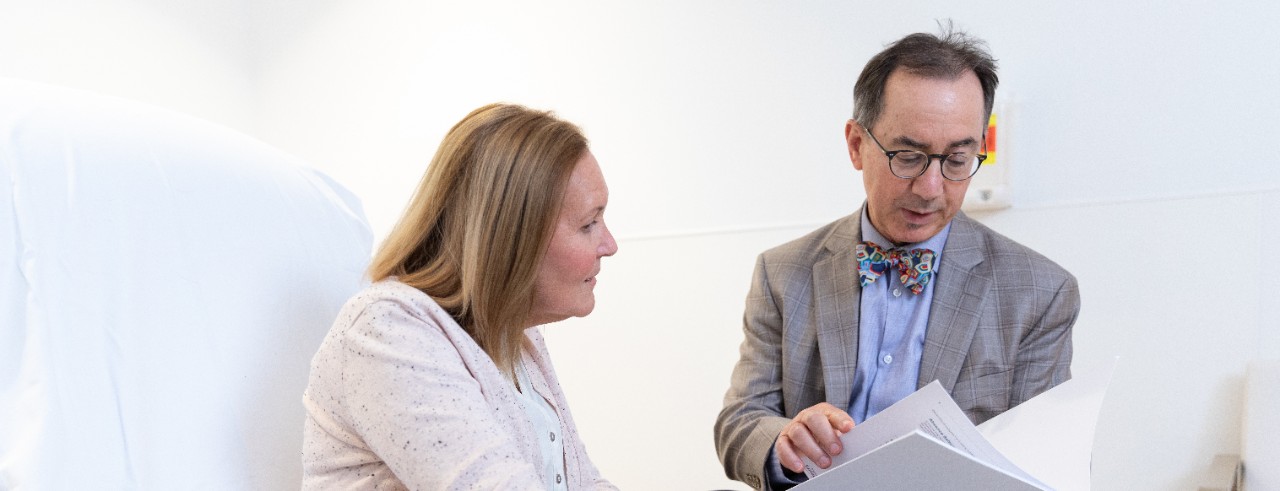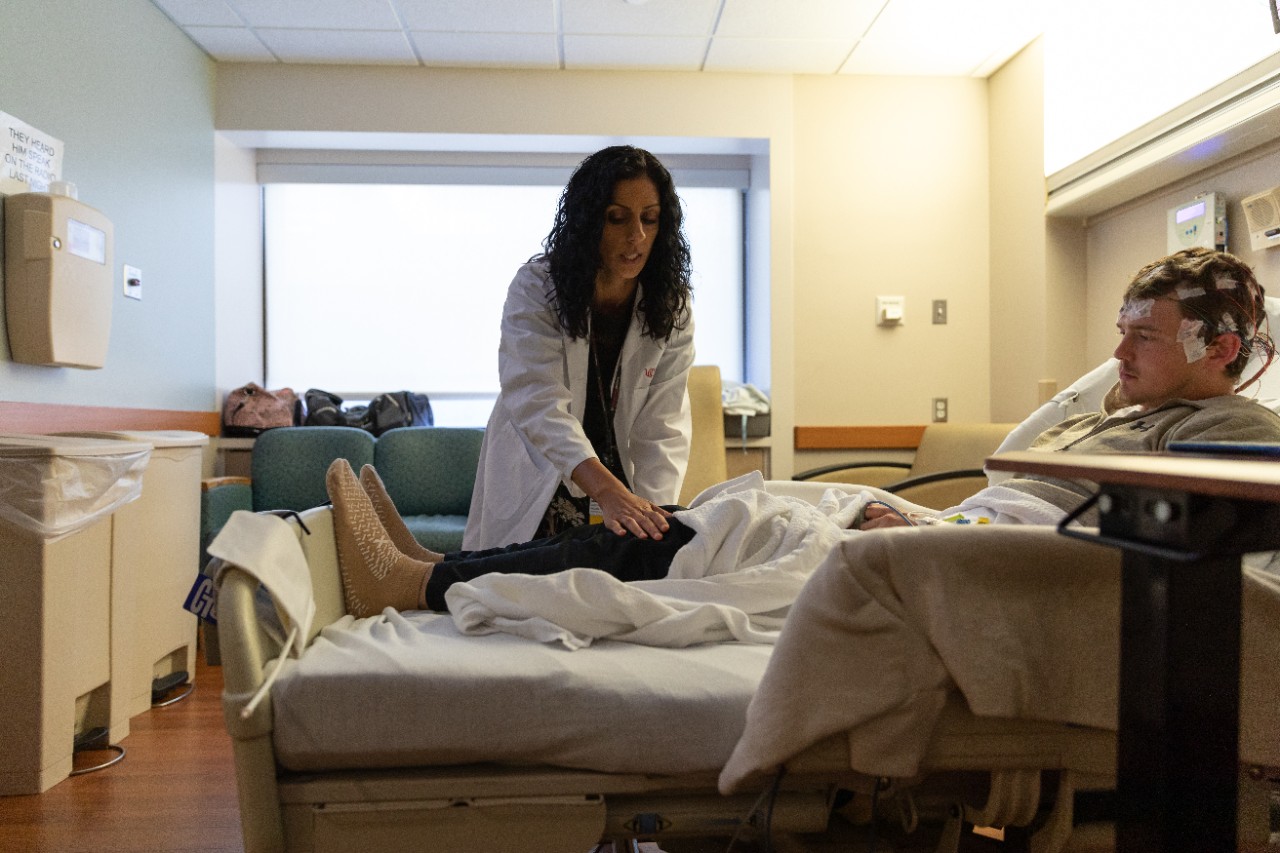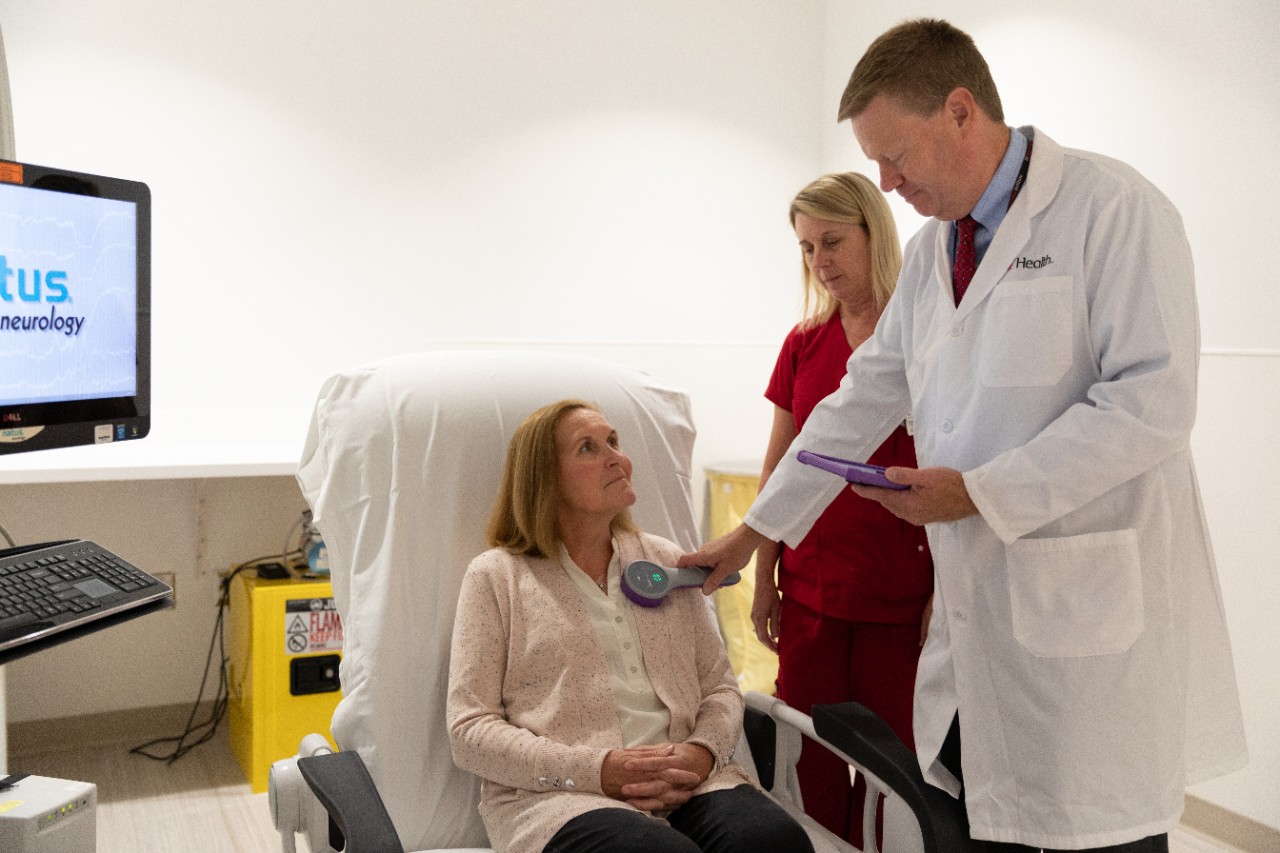
Trailblazing a new approach to neurology care
UCGNI becoming Learning Health System, begins with Epilepsy Center
How does a health care team deliver the best care to its patients and tangibly improve their physical and mental health and quality of life?
That is the motivating question that has led the University of Cincinnati Gardner Neuroscience Institute to the process of transforming into a Learning Health System (LHS), a new approach to medical research, clinical care and education.
Data-driven approach
Anne Paul, director of the LHS at UCGNI, said the concept of a Learning Health System has been around for about 20 years as an alternative to the current standard care model most popular in American health care. In a LHS, the health care organization decides to learn from every single data point they can gather about their patient population, she said.
“They are hospital systems that have developed an infrastructure, processes and a culture that puts learning at the core of everything they do,” Paul said. “What it translates into is that when patients come for a visit, or when patients contribute data in between visits, that data is captured and is used for two purposes: quality improvement and research.”
With data that is tracked closely and easy to visualize and compare across time, LHS teams can identify gaps in care and then track if the changes they make tangibly improve patient care.
“If we do see an impact, then we make that change a best practice and then we start scaling and spreading that best practice,” Paul said.
If we build a Learning Health System correctly, it will be truly transformational for our patients, our community and our organization.
Brett Kissela, MD
Research application
According to Paul, on average, it takes about 17 years for research findings to reach widespread application with a majority of patients, and even then there is variation in how new research is applied in real-world settings compared to the strict design of a study.
In an LHS, researchers and doctors collaborate more closely together to accelerate the transition of knowledge from the laboratory to the exam room. Rather than coming up with solutions looking for a problem, the team will identify real issues that are hindering patient improvement that will then form the basis of new research questions.
“When the researcher comes up with a possible solution that might work, then the clinical care team can take that and more quickly adapt that, because it’s been done in the context of the reality of their clinic,” Paul said. “It doesn’t mean that in a Learning Health System you can’t do clinical trials and your more traditional research, but what we are interested in developing at UCGNI is research that can quickly translate back to the care side because it’s been done in collaboration with the issues that the clinicians are facing.”

In a Learning Health System, physicians like Sheetal Malik, MD, are better equipped to quickly translate research from the lab to the patient's bedside. Photo provided by UC Health.
Patient-centered approach
Joseph Broderick, MD, said the Learning Health System approach is a continuous process of providers and patients working together to determine the most important factors to improve patient health, and having the right components in place to address these factors.
“You need dedicated people and processes in our UC Health system to look at how patients are doing, make the appropriate changes and monitor success,” said Broderick, professor in UC’s Department of Neurology and Rehabilitation Medicine in the College of Medicine, director of UCGNI and a UC Health physician. “And you don’t just stop after one success. You continue the process, working hand-in-hand with the patients.”
An LHS prioritizes close collaboration between health care professionals, patients and their families in a process called coproduction. Paul said patients and caregivers are treated as equals, as they bring their own expertise on their condition from their own experiences.
“In an LHS, the patients and caregivers are not this kind of external group that you go to on an annual or quarterly basis as a way to get feedback on already predefined ideas,” Paul said. “To coproduce with patients and caregivers means that you invite them into your clinical team’s quality improvement and research work.”
This is an opportunity to do some groundbreaking work here that translates into some research questions as well. I’m excited to see what’s going to happen with this and how this can play a role in our everyday care of patients with epilepsy.
David M. Ficker, MD
Paul said patients and caregivers in an LHS meet more regularly (sometimes weekly) with their care team to review data, identify gaps in care, brainstorm solutions, implement solutions and test effectiveness.
“They are the ones that are telling us what works and doesn’t work for them,” Paul said. “They are the ones that are connecting us to other patients and caregivers that they know of, because often those patients know each other.”
For example, if the data shows newly diagnosed patients are overwhelmed and forget much of what they are told during initial visits, the team might decide to create a notebook where patients can refer back to information they may have forgotten.
“You could have a nurse navigator write the entire notebook from cover to cover and then go to one of those patient groups and have them review and edit,” Paul said. “Or you could go to your patients and caregivers and say, ‘We need your help. Can you work with us in putting together a document that would really reflect what you wish you had known when you were newly diagnosed?’”
Paul said LHS research projects could include patients helping to write study protocols and consent forms that are easy to understand and serving as ambassadors in the community so more people are aware of the research.

David M. Ficker, MD, right, and his colleagues at the Epilepsy Center have piloted the implementation of UCGNI's Learning Health System. Photo provided by UC Health.
Brett Kissela, MD, said a Learning Health System provides an infrastructure that requires a “massive investment,” but is worth it to help make tangible improvements in the lives of patients with the patients being directly involved.
“As clinicians, we are always trying to get the best outcome for our patients, but we rarely have systems in place that allow us to actually obtain real-world outcomes and to enfranchise the patient and their loved ones in determining how to best provide systematic care for all patients with a particular illness,” said Kissela, the Albert Barnes Voorheis professor and chair in the Department of Neurology and Rehabilitation Medicine, executive vice dean and senior associate dean for clinical research in the UC College of Medicine and UC Health chief of research services.
First steps in epilepsy care
Over the last year, UCGNI’s Epilepsy Center has piloted the implementation of a Learning Health System. David M. Ficker, MD, said his team was already involved with LHS efforts at the national level led by the Epilepsy Foundation, which gave them a good foundation.
In coordination with national efforts, UC’s epilepsy team has focused on controlling seizures and reducing patient barriers to medication. Ficker said nationwide data showed a patient’s seizure frequency was only accurately documented during doctor visits about 45% of the time (UC’s rate was about 60% before implementing improvements), and about half of epilepsy patients did not track their seizures themselves at all.
“When we’re treating the patient, whether we’re looking at a change in treatment or offering some of the advanced epilepsy options like surgery, we need to know if the patient’s seizures are controlled or not,” said Ficker, professor in the Department of Neurology and Rehabilitation Medicine in UC’s College of Medicine and a UC Health physician.

Patients, caregivers, health care providers and Epilepsy Foundation representatives gathered in May for a brainstorming design session focused on care coordination for outpatients. Photo provided by UC Health.
Paul said 30% of epilepsy patients were found to have at least one barrier to medication from a list of 17 identified issues, including access or cost, forgetting to take the medication or not taking the medication due to its side effects. Only about 2% of patients were asked if they had any barriers to taking their medication at doctor’s appointments, Ficker said.
To remedy these problems, the team has encouraged patients to keep a seizure diary and gives questionnaires about seizure frequency and barriers to medication at each visit. A digital dashboard helps the team document and assess the data to look for patterns and potential interventions to reduce the number of seizures and barriers to medication.
“We now can assess what our seizure control rate is across our epilepsy population, which we’ve never been able to do with a quick click of a button,” Ficker said. “So we can look at trends over time, are we seeing gradual improvement in seizure control or are things not changing?”
Care coordination
Ficker said the team is beginning to look at other potential areas of improvement between patient visits to the doctor.
“We’re looking at care coordination efforts like pre-visit planning and what resources are available to patients in between visits that might help them,” he said. “We are also going to develop a strategy to identify patients that we would consider higher-risk whose seizures may not be controlled, who might be having issues with their medications, who might have some psychosocial issues and focus some resources on those patients.”
Care coordination has been developed in primary care and for conditions like diabetes, but Ficker said there has not been much advancement in the area of epilepsy.
“This is an opportunity to do some groundbreaking work here that translates into some research questions as well,” he said. “Even just the strategy used and looking at some outcomes after implementing the strategies, we clearly have a research component there.”
To that end, UC has received a grant from the Epilepsy Foundation and the Centers for Disease Control and Prevention to pilot a program that will equip community health workers within Greater Cincinnati to consult with and help high-risk patients with epilepsy between their doctor’s visits.
“I’m excited to see what’s going to happen with this and how this can play a role in our everyday care of patients with epilepsy,” Ficker said. “Our clinical staff, our medical assistants, our nurses have been involved with this, and I've been really impressed with how they’ve embraced this.”

Brainstorm participants identified key steps, failures and successes in clinic visits, communication between visits and self-management for patients with epilepsy. The data will be translated into interventions that will be prioritized and tested with the goal to improve patients' ability to control their seizures. Photo provided by UC Health.
Next steps
The work in epilepsy has laid a solid foundation of Learning Health System infrastructure, Paul said, that will continue to be implemented across each of UCGNI’s centers of excellence, with neurotrauma, headache, stroke and cognitive disorders being the next centers slated to transition to an LHS.
“A Learning Health System, as far as we know, hasn’t occurred to this point for patients with neurologic and psychiatric diseases,” Broderick said. “We want to be the national leader in this area and eventually find other health systems who will join our efforts to improve our patients’ health. We have made tremendous progress in just a year with our epilepsy patients and look forward to including all of our other UCGNI centers of excellence over the next five years.”
“In my mind, we currently do important work in all three missions of clinical care, research and education here at UC/UC Health,” Kissela added. “But if we build a Learning Health System correctly, it will be truly transformational for our patients, our community and our organization.”
Featured photo at top of Michael Privitera, MD, speaking with a patient. Photo courtesy of UC Health.
Innovation Lives Here
The University of Cincinnati is leading public urban universities into a new era of innovation and impact. Our faculty, staff and students are saving lives, changing outcomes and bending the future in our city's direction. Next Lives Here.
Related Stories
UC COVID-19 studies awarded $425K
April 15, 2020
Understanding that time was of the essence in combating this highly infectious disease, UC and its College of Medicine’s Office of Research conducted a rapid review and distribution of $425,000 in novel pilot grants to researchers, focusing on eradicating the disease.
Educational breast cancer event focuses on empowerment
Event: November 3, 2018 9:00 AM
"Beyond Breast Cancer: The Path to Empowerment” is an educational event for breast cancer survivors, their families and the community; it will be held from 9 a.m. to 3 p.m. Saturday, Nov. 3, at the Kingsgate Marriott Conference Center, 151 Goodman Drive.
Yahoo News: Five Black UC faculty members receive National...
September 8, 2020
Five African-American researchers and healthcare professionals on UC’s medical campus have received sizable grants from the National Institutes of Health during the past 18 months. The faculty members were interviewed by WCPO to help showcase innovation and the diverse voices and perspectives they bring as the healthcare community attempts to ease health disparities in communities of color in Cincinnati and beyond.
